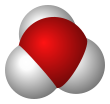| |||
| |||

| |||
| Names | |||
|---|---|---|---|
| IUPAC name
Bromane[1]
| |||
| Other names
Hydronium bromide
Bromhydric acid | |||
| Identifiers | |||
3D model (JSmol)
|
|||
| ChEBI | |||
| ChEMBL | |||
| ChemSpider | |||
| ECHA InfoCard | 100.240.772 | ||
| EC Number |
| ||
| 620 | |||
| KEGG | |||
PubChem CID
|
|||
| RTECS number |
| ||
| UNII | |||
| UN number | 1048 1788 | ||
| |||
| |||
| Properties | |||
| HBr(aq) | |||
| Molar mass | 80.91 g·mol−1 | ||
| Appearance | colorless liquid (impure samples can appear yellowish) | ||
| Odor | acrid | ||
| Density | 1.49 g/cm3 (48% w/w aq.) | ||
| Melting point | −11 °C (12 °F; 262 K) (47–49% w/w aq.) | ||
| Boiling point | 122 °C (252 °F; 395 K) at 700 mmHg (47–49% w/w aq.) | ||
| 221 g/100 mL (0 °C) 204 g/100 mL (15 °C) 130 g/100 mL (100 °C) | |||
| Acidity (pKa) | −9[2] | ||
| Viscosity | 0.84 cP (−75 °C) | ||
| Thermochemistry | |||
Heat capacity (C)
|
29.1 J/(K·mol) | ||
Std molar
entropy (S⦵298) |
198.7 J/(K·mol) | ||
Std enthalpy of
formation (ΔfH⦵298) |
−36.3 kJ/mol | ||
| Hazards | |||
| GHS labelling: | |||
 
| |||
| Danger | |||
| H314, H335 | |||
| P260, P261, P264, P271, P280, P301+P330+P331, P303+P361+P353, P304+P340, P305+P351+P338, P310, P312, P321, P363, P403+P233, P405, P501 | |||
| NFPA 704 (fire diamond) | |||
| Flash point | Non-flammable | ||
| Safety data sheet (SDS) | ICSC 0282 | ||
| Related compounds | |||
Other anions
|
Hydrofluoric acid Hydrochloric acid Hydroiodic acid | ||
Related compounds
|
Hydrogen bromide | ||
Except where otherwise noted, data are given for materials in their standard state (at 25 °C [77 °F], 100 kPa).
| |||
Hydrobromic acid is an aqueous solution of hydrogen bromide. It is a strong acid formed by dissolving the diatomic molecule hydrogen bromide (HBr) in water. "Constant boiling" hydrobromic acid is an aqueous solution that distills at 124.3 °C (255.7 °F) and contains 47.6% HBr by mass, which is 8.77 mol/L. Hydrobromic acid is one of the strongest mineral acids known.
- ^ Favre, Henri A.; Powell, Warren H., eds. (2014). Nomenclature of Organic Chemistry: IUPAC Recommendations and Preferred Names 2013. Cambridge: The Royal Society of Chemistry. p. 131. ISBN 9781849733069.
- ^ Bell, R. P. The Proton in Chemistry, 2nd ed., Cornell University Press, Ithaca, NY, 1973.




